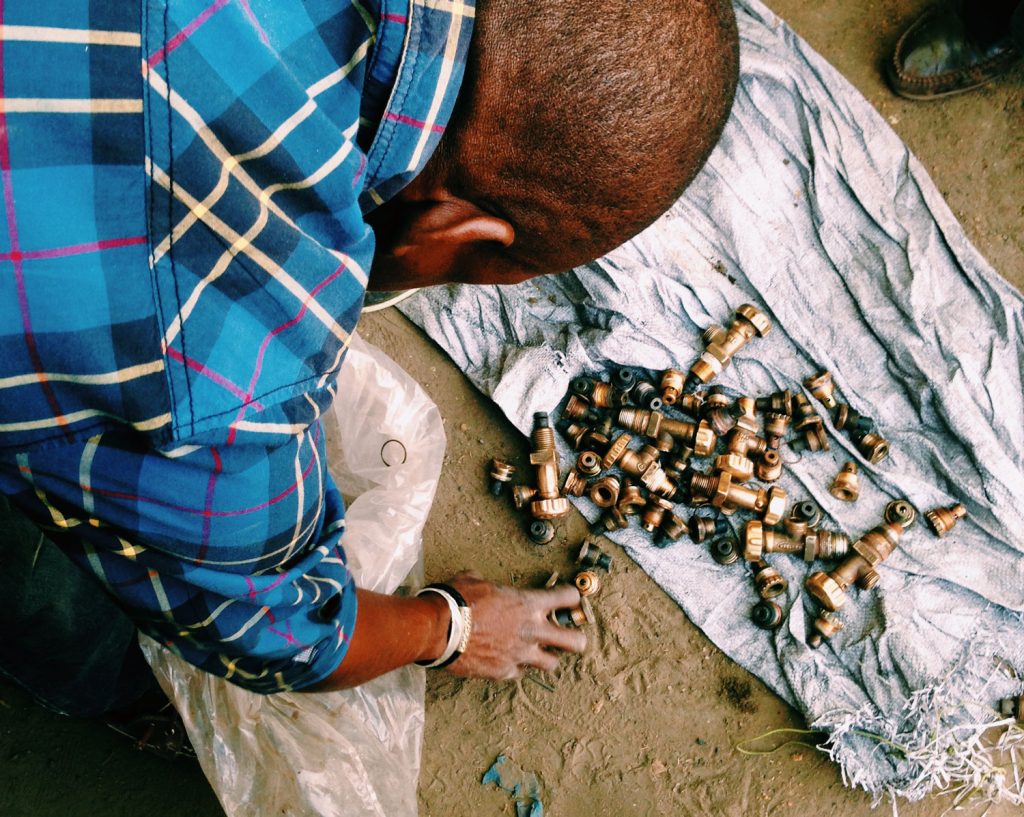
Ancient Art: Bringing Lost Wax to Life in Burkina Faso
We are excited to share this story of from Rachel Boss, who is currently living in Burkina Faso, working with Mennonite Central Committee’s Serving and Learning Together (SALT) program and Ten Thousand Villages. “I work as an Artisan Advisor, which means that I learn from Burkinabé artisans, gaining a deeper understanding of their artistic practices, do art of my own, and serve as a connecting link between Ten Thousand Villages and the artisans who are behind the products from Burkina Faso which Villages sells. It’s the most amazing work — artisans are immensely creative people, and I’m inspired each day by the way they create!” Rachel says.
Maker Story: Issouf from Burkina Faso
“I learned how to do bronze with my father. When I was a young boy, he would hold me in his arms while he worked on his craft. It was an apprenticeship that existed between father and son.”

Issouf sits on a ragged wooden stool against a cement wall. He’s concentrated, sweat dripping onto his hands as he gently shapes the bee’s wax model. He takes great care to get the proportions right. The mother’s hands are perfectly positioned under the book she holds with a child poised on her lap. Issouf decides the child’s head looks a little small. He adds more wax. “Et viola”, he says with quiet satisfaction as he holds it up to show me.
Issouf and his team of around twelve artisans work to create lost wax bronze pieces for Ten Thousand Villages. “Everyone is happy here. We don’t get in fights, we have discussions. I seek to understand each person I work with, to really know them. We’re like a family.”
Lost wax bronze making is an intense process, and is one of the oldest known forms of bronze casting in the world, dating back to the 3rd millennium BC, having sustained little change since its inception.
Starting with a bee’s wax form, artisans sculpt their models and then cover them with banco, a mixture of donkey dung and mud which has been arduously pounded together with a pestle, the same material used to construct homes in Burkina and other nations around the world.
Adding two layers of banco over the wax, he creates a small hole which reveals only a portion of the wax model. After baking under the midday Sahelian sun for a few hours, Issouf will bake the hardened, now unrecognizable form once again, this time in white hot coals of what seems like an ever-burning fire. He’ll tend the coals, turning the pieces so that the wax leaves the model through the small hole completely.

Surely this is a craft of patience, and endurance. Standing over a fire, in the sun, which at mid-day in Burkina can heat workshops to well over 100*F (39*C) without the addition of white-hot flames is not for the faint of heart (or for those who are prone to fainting in general).
After the wax is melted completely from the model, it’s time to heat the bronze. Various artisans have told me that bronze melts at around 1,200* C, or 2,300* F. Artisans use any recycled bronze they can find — bullet casings, bronze knobs from gas tanks, and old bits and pieces they’ve collected.

Carefully pouring the molten bronze into the stone-hard banco model, it’s left to sit for hours, sometimes days, to harden. Once cooled, the earthen model is broken by hammers and small chisels, revealing a rough, many times incomplete, bronze statue.

The abrupt edges of statues are smoothed with large metal files, and that’s when the pieces, borne from donkey dung and bullet casings, truly shine.
As a final touch, artisans add patina, breathing life and dimension into their pieces.
And then the process begins again.
Because banco models must be broken away from the bronze that lies beneath, every lost-wax bronze statue is unique. After creating this piece, Issouf must start the process again from his chunk of beeswax.
A craft shaped by millenia of practice, Ten Thousand Villages has invested in preserving something that is at the heart of Burkinabé artisanal culture. And not only is the historical art form maintained, it’s celebrated when invested in. It’s given value and made accessible in the international market-place. By paying him a fair wage for the work he loves, Issouf takes great pride in his work and the life he lives. “With the work Ten Thousand Villages supplies, I have been able to save money, and eventually built my own house, the one you see here. I am proud of the work I do.”
To read more about Rachel’s experience in Burkina Faso, visit her blog, Bonjour Burkina.

Leave a comment